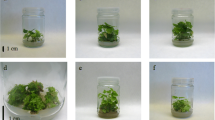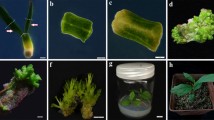Abstract
A micropropagation protocol that allows for the efficient cloning of C. hystrix was developed using 1 mm shoot-tip explants prepared from plants grown in the greenhouse. Establishment of Stage I cultures was greatest (83%) when shoot tips were cultured in modified MS (Murashige and Skoog, 1962) medium containing (per liter) 30 g sucrose, 0.1 g myo-inositol, and 5 g Agargel plus 1.7 μM indole-3-butyric acid (IBA), 0.5 μM kinetin and 0.3 μM gibberillic acid (GA3) (IKG). Benzyladenine (BA, 5 μM) proved best for Stage II shoot proliferation. Over 35 shoots were obtained per vessel (five shoots per vessel) when explants were cultured in medium containing BA. Less than 10 shoots were obtained per vessel when kinetin (0.5–5 μM) and IKG were used. Stage II cultures established from 1 cm shoot tips obtained from Stage I shoots produced more shoots (1.3-fold) than single node explants. Rooting and plantlet acclimatization were best when shoots greater than 1.5 cm were incubated in MS medium containing 0.5 μM naphthalene acetic acid (NAA). Higher NAA concentrations stimulated rooting but inhibited shoot elongation and reduced the ability of plantlets to survive acclimatization to ambient conditions. Plantlet height influenced acclimatization. Over 72% of plantlets survived acclimatization if they were at least 4.6 cm when transferred to soilless growing medium.
Similar content being viewed by others
References
Anonymous (1998) Statistics® for Windows. Analytical Software, Tallahassee, FL
Carmer SG & Seif RD (1962) Calculation of orthogonal coefficients when treatments are unequally replicated and/or unequally spaced. Agronomy J. 55: 387–389
Chen JF, Staub JE, Tashiro Y, Isshiki S & Miyazaki S (1997) Successful interspecific hybridization between Cucumis sativus L. and C. hystrix Chakr. Euphytica 96: 413–419
Chen JF, Adelberg JW, Staub JE, Skorupska HT & Rhodes BB (1999) A new synthetic amphidiploid in Cucumis from a C. sativus χ C. hystrix F1 interspecific hybrid. In: McCreight JD (ed) Cucurbitaceae '98: Evaluation and Enhancement of Cucurbit Germplasm (pp 336–339). ASHS Press, Alexandria, VA
Compton ME & Gray DJ (1992) Micropropagation as a means of rapidly propagating triploid and tetraploid watermelon. Proc. Fla. State Hort. Soc. 105: 352–354
Compton ME, Gray DJ & Elmstrom GW (1993) A simple protocol for micropropagating diploid and tetraploid watermelon using shoot–tip explants. Plant Cell Tiss. Org. Cult. 33: 211–217
Compton ME & Mize CW (1999) Statistical considerations for in vitro research: II — Birth of an idea to collecting data. In Vitro Cell. Dev. Biol. Plant 35: 115–121
Handley LW & Chambliss OL (1979) In vitro propagation of Cucumis sativus L. HortScience 14: 22–23
Mize CW, Koehler K & Compton ME (1999) Statistical considerations for in vitro research: II — Data to presentation. In Vitro Cell. Dev. Biol. Plant 35: 122–126
Murashige T & Skoog F (1962) A revised medium for rapid growth and bioassays with tobacco tissue cultures. Physiol. Plant. 15: 473–497
Pink DAC & Walkey DGA (1984) Rapid propagation of Cucurbita pepo L. by culture of meristem tips. Sci. Hort. 24: 107–114
Author information
Authors and Affiliations
Corresponding author
Rights and permissions
About this article
Cite this article
Compton, M.E., Pierson, B.L. & Staub, J.E. Micropropagation for recovery of Cucumis hystrix. Plant Cell, Tissue and Organ Culture 64, 63–67 (2001). https://doi.org/10.1023/A:1010645206280
Issue Date:
DOI: https://doi.org/10.1023/A:1010645206280




